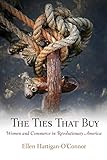The Ties That Buy : Women and Commerce in Revolutionary America / Ellen Hartigan-O'Connor.
Material type: TextSeries: Early American StudiesPublisher: Philadelphia : University of Pennsylvania Press, [2012]Copyright date: ©2009Description: 1 online resource (264 p.) : 18 illusContent type:
TextSeries: Early American StudiesPublisher: Philadelphia : University of Pennsylvania Press, [2012]Copyright date: ©2009Description: 1 online resource (264 p.) : 18 illusContent type: - 9780812221596
- 9780812203943
- 381.082/0973
- online - DeGruyter
- Issued also in print.
| Item type | Current library | Call number | URL | Status | Notes | Barcode | |
|---|---|---|---|---|---|---|---|
 eBook
eBook
|
Biblioteca "Angelicum" Pont. Univ. S.Tommaso d'Aquino Nuvola online | online - DeGruyter (Browse shelf(Opens below)) | Online access | Not for loan (Accesso limitato) | Accesso per gli utenti autorizzati / Access for authorized users | (dgr)9780812203943 |
Browsing Biblioteca "Angelicum" Pont. Univ. S.Tommaso d'Aquino shelves, Shelving location: Nuvola online Close shelf browser (Hides shelf browser)

|

|

|

|

|

|

|
||
| online - DeGruyter Women's Radical Reconstruction : The Freedmen's Aid Movement / | online - DeGruyter Exile and Return Among the East Timorese / | online - DeGruyter Human Rights NGOs in East Africa : Political and Normative Tensions / | online - DeGruyter The Ties That Buy : Women and Commerce in Revolutionary America / | online - DeGruyter The Ruins of Experience : Scotland's "Romantick" Highlands and the Birth of the Modern Witness / | online - DeGruyter Gender and Heresy : Women and Men in Lollard Communities, 1420-1530 / | online - DeGruyter Marriage, Sex, and Civic Culture in Late Medieval London / |
Frontmatter -- Contents -- Introduction -- Chapter 1. Urban Housefuls -- Chapter 2. Work in the Atlantic Service Economy -- Chapter 3. Family Credit and Shared Debts -- Chapter 4. Translating Money -- Chapter 5. Shopping Networks and Consumption as Collaboration -- Chapter 6 The Republic of Goods -- Conclusion -- Notes -- Index -- Acknowledgments
restricted access online access with authorization star
http://purl.org/coar/access_right/c_16ec
In 1770, tavernkeeper Abigail Stoneman called in her debts by flourishing a handful of playing cards before the Rhode Island Court of Common Pleas. Scrawled on the cards were the IOUs of drinkers whose links to Stoneman testified to women's paradoxical place in the urban economy of the late eighteenth and early nineteenth centuries. Stoneman did traditional women's work-boarding, feeding, cleaning, and selling alcohol-but her customers, like her creditors, underscore her connections to an expansive commercial society. These connections are central to The Ties That Buy.Historian Ellen Hartigan-O'Connor traces the lives of urban women in early America to reveal how they used the ties of residence, work, credit, and money to shape consumer culture at a time when the politics of the marketplace was gaining national significance. Covering the period 1750-1820, the book analyzes how women such as Stoneman used and were used by shifting forms of credit and cash in an economy transitioning between neighborly exchanges and investment-oriented transactions. In this world, commerce reached into every part of life. At the hearths of multifamily homes, renters, lodgers, and recent acquaintances lived together and struck financial deals for survival. Landladies, enslaved washerwomen, shopkeepers, and hucksters sustained themselves by serving the mobile population. A new economic practice in America-shopping-mobilized hierarchical and friendly relationships into wide-ranging consumer networks that depended on these same market connections.Rhetoric emerging after the Revolution downplayed the significance of expanding female economic life in the interest of stabilizing the political order. But women were quintessential market participants, with fluid occupational identities, cross-class social and economic connections, and a firm investment in cash and commercial goods for power and meaning.
Issued also in print.
Mode of access: Internet via World Wide Web.
In English.
Description based on online resource; title from PDF title page (publisher's Web site, viewed 24. Apr 2022)


